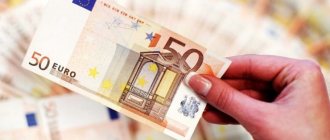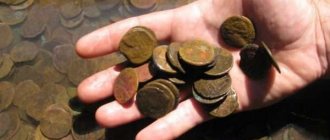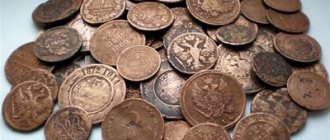The European currency is considered one of the world's. It is expensive and popular, which is why counterfeiters often try to counterfeit it. And there are quite a lot of comic banknotes imitating the euro. When traveling you will have to contact the euro. But how can you avoid making a mistake due to inexperience and mistaking a counterfeit for a real banknote? What kind of euro bills and coins are there anyway? Let's figure it out.
General characteristics of the euro
When starting to study the issue of euro money, the first thing to note is the number of monetary units. There are 7 denominations for banknotes and 8 for coins.
Banknotes in denominations of 5, 10, 20, 50, 100, 200 and 500 euros are used.
Important! Sometimes on the Internet you can find advertisements for the sale of collectible 1,000 euros. There is no such means of payment. This is a fraud.
The coins have denominations: 1, 2, 5, 10, 20, 50 cents. From this series, 1 and 2 euros stand out. We will discuss the topic in more detail below.
Both paper and metal cash are characterized by the same style of printing and designs used. The denomination determines the size of the bill itself and what color is used for it.
Note 1.
The higher the denomination of the banknote, the larger it is in size.
On the front side
money there are images of a variety of gates, windows and facades, which is a symbol of openness to the world and willingness to cooperate.
On the reverse side
you can see bridges, which in turn symbolize the desire for limitless communication with other states and peoples.
Note 2.
All drawings on the euro are schematic illustrations. They relate to different historical eras and do not represent objects that exist in reality. Interestingly, Robert Kalina, the author-designer, initially used images of real objects, but they were later replaced for political reasons.
What common elements can be seen on euro banknotes:
- European Union flag with twelve stars;
- the abbreviation “ECB” (European Central Bank), which is written in five languages;
- signature of the bank manager;
- name of the currency in Greek and Latin;
- map of Europe (on the back).
Details can be found below.
€500
The highest denomination banknote in circulation is purple. Size – 160 x 82 mm. The design uses modern architectural objects: buildings and bridges that are being built everywhere today.
On the outside there is a skyscraper made of glass and concrete. From the inside there is a massive suspension bridge, and below it is the faded silhouette of another bridge. The issue of this banknote ceased in 2016, but it is still an official means of payment and is in circulation until it is naturally withdrawn from circulation.
What protection do banknotes have?
The euro is one of the most protected currencies. When printing, only modern chemicals and technologies are used.
Material used
– specially designed cotton paper.
It is seriously durable. At the same time, if you crush money, you will hear a slight crunch. It does not glow in ultraviolet light.
The front side is smooth, but the back is rough.
The denomination, the abbreviation "ECB" (five languages), the year of issue and the main illustration are created using relief printing
. All of these elements can be easily felt blindly.
Watermarks are also used
: areas of different densities are combined.
Nearby you can distinguish vertically oriented stripes: they are made in dark and light colors - this is a barcode
.
Depending on the denomination, two types of hologram
.
There is a silver stripe across the entire width of the banknote for 5, 10 and 20 euros. For other money there is a geometric overlay. Both options involve pressed printing on foil
: it has a three-dimensional image effect.
The hologram has micro-perforation
in the form of a banknote - it is identical for all banknotes. The image itself is made using a laser and cannot be detected by touch.
The 5, 10 and 20 euro notes have a golden shiny stripe.
. If you tilt the bill, you can see the denomination number and the designation of the European currency from different angles. The pearlescent shine is achieved through the use of iridescent paint.
Watermark on the left side of the 10 euro banknote
Which countries use
Euro banknotes, their denomination and photos are well known in all European countries.
It is the official currency in:
- Estonia;
- Austria;
- France;
- Belgium;
- Finland;
- Germany;
- Slovenia;
- Greece;
- Slovakia;
- Ireland;
- Portugal;
- Spain;
- the Netherlands;
- Cyprus;
- Malta;
- Latvia;
- Luxembourg;
- Lithuania.
Some territories do not belong to the European Union, but officially use this currency under an agreement with the ECB.
Other states use such money unofficially:
| Officially | Unofficially |
| Miquelon and Saint Pierre | Kosovo |
| Vatican | Montenegro |
| Monaco | Saint Martin |
| San Marino | Saint Barthelemy |
| Andorra | Dhekelia and Akrotiri |
Not all countries planning to join the European Union or those that have already joined it agree to switch to this currency. For example, in Sweden they do not plan to switch to this money and want to preserve the local traditional currency.
Banknotes
So, what money is in circulation in 2022? Below we will pay attention to all the denominations of paper euros currently in circulation - their main topics, including, and also give an example of a photo of banknotes. All the money notes we will mention are still in use today, and many of them are of a new design.
5
The smallest denomination. The bill is made in gray tones. It depicts elements of architecture and more:
- front side – triumphal arch, EU emblem (12 stars all around);
- turnover - aqueduct.
Dimensions:
120 mm by 62 mm.
The banknote is protected by a watermark - an arch and a number. There is a security thread on the left, on which you can see the inscription “5 EURO”.
The face of the money has a holographic ribbon. When you turn it, a banknote, the number 5 and the name in Greek and Latin appear.
5 euro banknote. Front side with arch and back side with aqueduct
10
This banknote is made in red. The illustration shows Romanesque style architecture.
Dimensions:
127 by 67 millimeters.
There is an arch on the face of the money. On the back is a stone bridge (the basis of the image is the Saint-Benez bridge).
Water signs
represented by the number 10 and an arch.
On the left side of the security thread
you can see the inscription “10 EURO”.
On the hologram
you can see the denomination and currency symbol.
Under ultraviolet light,
the 12 stars turn orange, the map and bridge turn green, and the background darkens.
10 euros. Face and back with arch and stone bridge
20
This is a bill of a bluish tint size
133 by 72 millimeters.
On the front side there is an arched window made in the Gothic style. The reverse shows a bridge from the 13th – 14th centuries.
Elements available: EU stars, flag, map.
Defense presented
watermarks, vertically oriented thread and holographic tape.
20 euros. Gothic arch and bridge style on the face and back of the note
50
This denomination is equipped with an orange color. Banknote dimensions
– 147 by 77 mm.
Front side: window in Renaissance style. Back: bridge.
Watermark
is, in fact, an image of the goddess who gave her name to Europe.
Interestingly, the name euro is also printed in Cyrillic. This is explained by the fact that at some point Bulgaria joined the EU, which was noted with a similar innovation.
It is possible to determine the denomination by touch (functional for the visually impaired). There are ribbed oblique stripes on the sides of the bill.
Orange 50 euro banknote
100
Money of this denomination has a greenish tint, which partly associates it with dollars.
The architectural elements used in the images belong to the Baroque and Rococo styles: an arch with atlases and a bridge.
Dimensions:
147 by 82 mm.
Traditional symbols available: 12 stars, EU flag, map, signature of the ECB director.
Watermark
can be viewed from both sides against the light.
It is made in the form of an arch. The security thread
has the inscription “100 EURO”. There is a hologram on the right side of the front side.
Under ultraviolet light
the stars take on an orange tint, the bridge and map turn green, and the background turns dark blue.
There are security features typical of high denomination banknotes, such as microprinting, matte finish, perforation and matching elements of the number 100.
One of the three largest denomination notes - 100 euros
200
What first catches your eye is the bright yellow color of the banknote. The images illustrate architecture using steel and glass (Art Nouveau style).
153 by 82 millimeters – banknote dimensions
s.
On the face of the money, a gate with glass inserts is visible. On the back is a metal bridge and a map of Europe.
EURion (12 stars), watermarks and security thread are also in place.
The matte finish of the image is complemented by perforation and microprinting.
On the front side at the bottom there are vertical lines in relief - they help to identify the banknote tactilely.
200. Yellow banknote
500
This is the largest banknote - both in size and in denomination. Published since 2002. Today it is no longer produced, although it is in circulation.
The color of money is purple. The architectural elements illustrated are from modern buildings.
Dimensions:
160 by 80 mm.
On the front side there is an image of a modern glazed reinforced concrete building. On the back are suspension bridges.
The banknote has a watermark indicating the denomination and a hologram. In addition to this, there are other security elements: colored fibers, microtext, etc.
To the touch you can note the special strength of the paper and its relief.
The largest bill. Purple 500 euros
€200
The design of the banknote focuses on yellow-brown shades. Size – 153 x 82 mm. The images emphasize modernity with the use of neo-Gothic elements, glass and metal. The front side is decorated with an image of a gate made of glass and metal. On the reverse side there is a drawing of a bridge, the design of which resembles modern buildings. It consists of one span: the upper part is straight, the lower part is semicircular.
Coins
We already mentioned above that there are only 8 coins. 6 of them are cents. Two more - euro.
Although minting occurs in different countries, and the design may differ slightly, there are still elements common to all coins:
- map of Europe and denomination against its background;
- 12 stars on reverse and obverse;
- uniform font;
- sketchiness.
The reverse of 1, 2 and 5 cents features an image of the Earth with Europe indicated on it. 10, 20 and 50 cents show EU members who have not yet united, but are striving for this. 1 and 2 euros already demonstrate Europe as a single whole – without any borders.
Note 3.
No country has the right to change the reverse. It is universal for everyone. The obverse may contain elements that are installed by the issuer, although, for example, 12 stars on the outer circle still remain.
Cents and euros. Coins
Specifics of stamping
Each EU member can mint unique coins. Their obverse will be different from the others - it is considered the “national side”. At the same time, 12 stars are an indispensable attribute of all money
.
There are 23 obverse options in total.
Some states have created several types of coins of the same denomination. For example, Belgium issued 4 varieties of 1 euro from 1999 to 2014.
Cents
Current denominations: 1, 2, 5, 10, 20, 50.
The first three coins are steel. They are reddish in color, because... covered with copper. Their edge is smooth (with the exception of 2 cents, which have a groove).
Money from 10 to 50 cents is made of “Scandinavian gold” (a special alloy based on copper - with the addition of aluminum, zinc and tin). The edge of such coins is ribbed.
The 20 cents are especially distinctive - the so-called “Spanish flower”: seven indentations across equal sections of diameter.
1 and 2 euros
A characteristic feature is the bimetallic composition. The structure has an inner circle as well as an outer one (with 12 stars). The outer circle of 1 euro is made of yellow metal, and that of 2 is made of white metal.
The 2 euro coin is in particular demand among numismatists.
The edge of 1 euro is six alternating segments (three smooth, three ribbed). In the case of 2 euros, there is also an inscription, which is determined by the country where the coin was minted: for Germany it is “EINIGKEIT UND RECHT UND FREIHEIT” (without quotes), for the Netherlands it is “GOD ★ ZIJ ★ MET ★ ONS ★” (inscription “ God is with us” – has asterisks inside between the words).
Anniversary and commemorative money
Commemorative coins are usually 2 euro coins. Today there are 309 varieties
.
Important! Each EU state has the right to issue its own souvenir coins, which depict significant events in the history of the state. We often talk about independence anniversaries.
There is also money whose issue has one theme that unites all EU members.
Important! Souvenir/commemorative coins are legal tender. However, due to their collectible value, rarely does anyone use them for their intended purpose.
Over the entire existence of the European Union, the following general series have been implemented:
- Treaty of Rome, 2007 – 13 coins;
- 10th anniversary of the Economic and Monetary Union, 2009 – 16 mon.;
- 10th anniversary of the euro, 2012 – 17 mon.;
- 30th anniversary of the EU flag, 2015 – 19 mon.
Example 1.
Some countries issue series of commemorative money. For example, in Germany there are 16 types of coins in use, dedicated to the theme of the Federal States. A series of “UNESCO Cultural and Natural World Heritage Monuments” has been organized in Spain.
German 2 euro coin.
Series “Treaty of Rome” Note 4.
There are also coins with a denomination of 5 euros. It can be used as a means of payment, but only in the territory of the issuing country. It is rarely present in circulation, because considered collectible.
History of appearance
For the first time, the idea of creating money common to all of Europe arose at the beginning of the 20th century. Already in 1929, such an innovation was proposed in the League of Nations.
In 1969, the European Economic Community attempted to create a union with a single economy and common money. This was necessary to better coordinate monetary cooperation. In 1970, a report by Pierre Werner, Prime Minister of Luxembourg, was published. At that time, no single money was proposed and no attempt was made to develop one. The strategy proposed in the report did not justify itself.
In March 1979, a currency system was created for all European territories. This was not yet a single money, but already a way to fix and stabilize exchange rates for local currencies. The creation of a common currency for states wishing to do so came in 1992. They committed to develop it by January 1999. The launch date was set on the 1st of this month.
The first participating countries were selected:
- Austria;
- Luxembourg;
- Germany;
- Italy;
- Finland;
- Belgium;
- Ireland;
- Portugal;
- France;
- Spain;
- Netherlands.
At first, money was introduced in the form of traveler's checks, electronic transactions and other non-cash transactions. Nevertheless, the local money of the states participating in the project continued to exist, but tied to the euro. On January 1, 2002, the new currency was introduced in the countries participating in the project as a full-fledged means of payment. From that moment on, local money stopped working.
Banknotes of the 2002 sample were issued until 2013, when a new edition was released. It is still in circulation today. Countries that join the European Union most often gradually switch to using the euro. Sometimes they start doing this in advance, officially or not.
State codes and cliches
Only the national central banks of European countries have the right to print banknotes and issue euro coins. As part of this activity, they are subordinate to the ECB. The Council of the European Central Bank, among other things, is responsible for decisions regarding the additional issue
.
Note 5.
The ECB Council always includes representatives of the national banks of the European Union.
Where money is made is determined by each country individually. Both their own printing centers and production facilities in another state can be used.
Important! Euro denominations have their own numbers - by the first letter in it you can determine which country is the issuer of the banknote. A specific issuer is identified by a checksum that plays the role of protection against counterfeiting.
Example 2.
Finland is the letter “L”, Portugal is “M”, Italy is “S”. It is curious that, for example, Luxembourg does not have its own letter, since this state entity does not issue cash at all.
The cliche number consists of 6 characters - they contain information about the printing house where the banknotes were printed. Under no circumstances can the code coincide with the country number, and it is deciphered like this
:
- the letter defines the typography;
- three digits after the letter determine the number of the typographic block;
- the fifth character (letter) indicates the row of cliches;
- the sixth character (digit) is the number of the column where the banknote is placed on the cliche.
In Europe, private organizations operate on the same legal basis as state printing houses. They are issued licenses to carry out activities. For example, in Germany there are printing centers both in the east and in the west. In France, similar activities are carried out by government agencies and private organizations.
Where do they print?
Not all European countries where such money is in circulation print it. For this purpose, special cotton paper and paints are used.
Also, all manufacturers are assigned their own letter and control number:
| A country | Letter | Number |
| Estonia | D | 4 |
| Belgium | Z | 9 |
| Netherlands | R | 1 |
| France | U | 5 |
| Malta | F | 2 |
| Germany | X | 2 |
| Slovakia | E | 3 |
| Austria | N | 3 |
| Spain | V | 4 |
| Cyprus | G | 1 |
| Slovenia | N | 9 |
| Greece | Y | 1 |
| Finland | L | 5 |
| Italy | S | 7 |
| Ireland | T | 6 |
| Portugal | M | 4 |
By number and letter you can check whether the money is real.
Functions of the EU bank
Regulation of the euro is a matter of competence of the European Central Bank.
Note 6.
The ECB was founded in 1998, in June. The head office is located in Frankfurt. The leadership of the organization includes representatives of all members of the union. The head (director) is elected for a term of 8 years.
Main functions of the ECB:
- creation and implementation of foreign exchange regulation policies within the EU;
- control of monetary reserves of European Union states;
- issue of money;
- approval of rates;
- managing the state of the price range (inflation remains at 2%).
Thus, both the members of the union themselves and the European Central Bank, to which special powers have been delegated, are involved in regulating currency issues in Europe.
Interesting Facts
There are many interesting facts associated with the EU single currency. Some of them:
- the design of banknotes does not use brown color;
- With the advent of new cash, residents of Italy had to buy wallets en masse, since the banknotes turned out to be wider than the previous Italian lira;
- banknotes are convenient for visually impaired people and the blind, because they have different sizes and relief images;
- The euro holds first place in the world in terms of cash volume;
- It took 5 years to mint coins in the required quantity of 5 billion copies.
The name for the new currency appeared in 1995 in Spain. The author is the Belgian expert and Esperanto connoisseur Germain Pirlo.
Restrictions
In 2014, the ECB stopped producing new banknotes of this denomination, and two years later, the board of governors of the European Central Bank announced a ban on the release of this denomination into circulation. The ban was supposed to be in effect from December 2018, but in fact it started in April 2019.
Currently €500 is used in 23 EU states and is the maximum. In some non-EU countries, you can make a bank deposit with a banknote of this denomination, but its acceptance at specialized ATMs is prohibited.
In Denmark and the UK, you cannot exchange €500, nor can you purchase goods and services with it. Danish and English banks have not accepted this denomination since 2010 - in fact, it is banned.
Printing ink
Along with paper, the main printing materials include inks, by changing the properties of which the treasury protects its tickets from counterfeiting. In a rough approximation, paint consists of a coloring pigment and a certain binder composition. Fine colored powders are used as pigments, and varnishes, all kinds of resins, solvents, etc. are used as binding materials. To enhance the protective properties, in addition to the pigment and binder material, special substances are added to the printing ink, which give it special properties - luminescence in UV or IR light, magnetism, impossibility of copying, etc.
Hologram
All European banknotes have a hologram (or kinegram) in two variations - local and stripe. A kinegram is understood as a pressed image made on metallized foil, which has the effect of a three-dimensional image that changes at different viewing angles:
- Local hologram. Located on the obverse narrow coupon field of bills over 50 €. It has a precise geometric shape and changes the image from a digital writing of the denomination to an architectural composition against a background of colored diverging spheres.
- Stripe hologram. Applied to the lower group of denominations and protected by perforation.
Serial numbers
Series numbers of euro banknotes have 11 numeric digits and one letter, and are printed in two letterpress colors. Like all other world currencies, they have a special font for numbers and alphabetic symbols, which reveal differences even if they seem absolutely similar. The generation of numbers is not random, but occurs according to a special algorithm, which implies certain and not devoid of interest mathematical patterns, discussed below.
Country of issue
If you add up all the numbers in the serial number row, the first number will initially be two digits. After summing the resulting digits of this number and reaching a single digit, a figure is obtained that corresponds to the classification of the country that issued this banknote. According to this classification, each country that legally has the right to print European currency is assigned a certain letter (letter) and a specific number within the range of 1-9.
Check sum
It is the same for all euro banknotes and is equal to “8”. In order to reach the control eight, you need to sum up the serial number (11 digits) and add one more to them - the one that corresponds to the letter, if you count its serial number in the English alphabet. The result should always be the same number, which is invariably eight for a genuine banknote.











